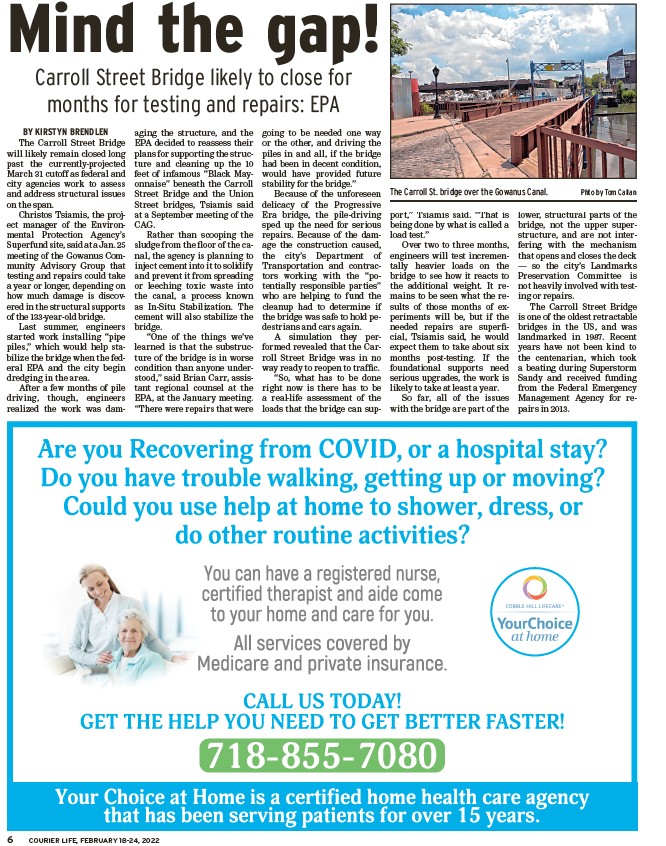
BY KIRSTYN BRENDLEN
The Carroll Street Bridge
will likely remain closed long
past the currently-projected
March 31 cutoff as federal and
city agencies work to assess
and address structural issues
on the span.
Christos Tsiamis, the project
manager of the Environmental
Protection Agency’s
Superfund site, said at a Jan. 25
meeting of the Gowanus Community
Advisory Group that
testing and repairs could take
a year or longer, depending on
how much damage is discovered
in the structural supports
of the 133-year-old bridge.
Last summer, engineers
started work installing “pipe
piles,” which would help stabilize
the bridge when the federal
EPA and the city begin
dredging in the area.
After a few months of pile
driving, though, engineers
realized the work was damaging
COURIER LIFE, F 6 EBRUARY 18-24, 2022
the structure, and the
EPA decided to reassess their
plans for supporting the structure
and cleaning up the 10
feet of infamous “Black Mayonnaise”
beneath the Carroll
Street Bridge and the Union
Street bridges, Tsiamis said
at a September meeting of the
CAG.
Rather than scooping the
sludge from the fl oor of the canal,
the agency is planning to
inject cement into it to solidify
and prevent it from spreading
or leeching toxic waste into
the canal, a process known
as In-Situ Stabilization. The
cement will also stabilize the
bridge.
“One of the things we’ve
learned is that the substructure
of the bridge is in worse
condition than anyone understood,”
said Brian Carr, assistant
regional counsel at the
EPA, at the January meeting.
“There were repairs that were
going to be needed one way
or the other, and driving the
piles in and all, if the bridge
had been in decent condition,
would have provided future
stability for the bridge.”
Because of the unforeseen
delicacy of the Progressive
Era bridge, the pile-driving
sped up the need for serious
repairs. Because of the damage
the construction caused,
the city’s Department of
Transportation and contractors
working with the “potentially
responsible parties”
who are helping to fund the
cleanup had to determine if
the bridge was safe to hold pedestrians
and cars again.
A simulation they performed
revealed that the Carroll
Street Bridge was in no
way ready to reopen to traffi c.
“So, what has to be done
right now is there has to be
a real-life assessment of the
loads that the bridge can support,”
The Carroll St. bridge over the Gowanus Canal. Phto by Tom Callan
Tsiamis said. “That is
being done by what is called a
load test.”
Over two to three months,
engineers will test incrementally
heavier loads on the
bridge to see how it reacts to
the additional weight. It remains
to be seen what the results
of those months of experiments
will be, but if the
needed repairs are superfi -
cial, Tsiamis said, he would
expect them to take about six
months post-testing. If the
foundational supports need
serious upgrades, the work is
likely to take at least a year.
So far, all of the issues
with the bridge are part of the
lower, structural parts of the
bridge, not the upper superstructure,
and are not interfering
with the mechanism
that opens and closes the deck
— so the city’s Landmarks
Preservation Committee is
not heavily involved with testing
or repairs.
The Carroll Street Bridge
is one of the oldest retractable
bridges in the US, and was
landmarked in 1987. Recent
years have not been kind to
the centenarian, which took
a beating during Superstorm
Sandy and received funding
from the Federal Emergency
Management Agency for repairs
in 2013.
Mind the gap!
Carroll Street Bridge likely to close for
months for testing and repairs: EPA